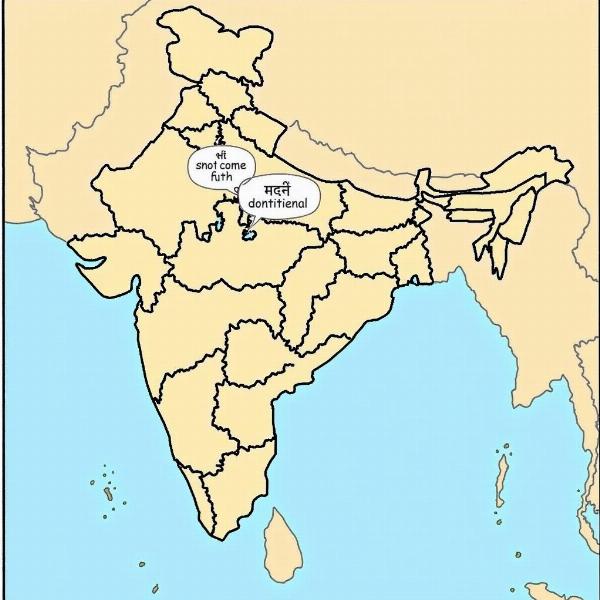Understanding the nuances of negation in Hindi can be tricky, especially when dealing with common phrases like “did not come.” This article aims to clarify the various ways to express “did not come” in Hindi, catering to different levels of formality and regional variations. Whether you’re a beginner learning the basics or seeking to refine your existing knowledge, this comprehensive guide will provide you with the necessary tools and insights.
Different Ways to Say “Did Not Come” in Hindi
Hindi offers several ways to convey the meaning of “did not come,” each with its own specific context and usage. Let’s explore some of the most common translations:
- नहीं आया (nahīṁ āyā): This is the most straightforward and commonly used translation, suitable for both formal and informal settings. It’s the masculine singular form.
- नहीं आई (nahīṁ ā’ī): This is the feminine singular form, used when referring to a female subject.
- नहीं आए (nahīṁ ā’e): This is the masculine plural form, used when referring to multiple male subjects or a mixed group.
- नहीं आईं (nahīṁ ā’īṁ): This is the feminine plural form, used when referring to multiple female subjects.
Choosing the correct form depends on the gender and number of the subject. Using the correct form is crucial for grammatical accuracy and effective communication.
Formal vs. Informal Usage
While the above translations are generally applicable, there are subtle variations depending on the formality of the situation. For instance, in a more formal context, you might use a more polite phrase like:
- पधारे नहीं (padhāre nahīṁ): This is a respectful way of saying “did not come,” often used for elders or respected individuals.
Conversely, in informal conversations, you could use more colloquial expressions, depending on the region.
Regional Variations
Hindi is a diverse language with numerous dialects and regional variations. While the core translations remain consistent, subtle differences exist in how “did not come” is expressed across different regions. For example, in some parts of North India, you might hear:
- नहीं आये (nahīṁ āye): This is another variation for the masculine plural, commonly used in informal settings.
 Regional Variations in Hindi
Regional Variations in Hindi
Common Questions Related to “Did Not Come”
Why is it important to understand the different forms of “did not come” in Hindi?
Mastering the various forms allows you to communicate effectively and accurately, demonstrating respect for the language and its nuances.
What are some other ways to express negation in Hindi?
Besides “nahīṁ,” other negative words like “mat” (don’t) and “na” (no/not) can be used to express negation in different contexts.
Expert Insights
According to Dr. Anjali Sharma, a renowned Hindi linguist, “Understanding the nuances of negation in Hindi is crucial for effective communication. Using the correct form not only conveys the intended meaning but also demonstrates respect for the language’s grammatical structure.”
Another expert, Mr. Rohan Verma, a Hindi teacher with over 20 years of experience, adds, “Learning the different regional variations enriches your understanding of the language and allows you to connect with people from diverse backgrounds.”
Conclusion
“Did not come meaning in hindi” encompasses a variety of expressions, ranging from simple to formal and across regional dialects. Choosing the appropriate translation depends on the context, gender, number of the subject, and the level of formality required. By understanding these nuances, you can communicate effectively and respectfully in Hindi.
FAQ
- What is the most common way to say “did not come” in Hindi? नहीं आया (nahīṁ āyā) is the most common translation.
- How do you say “did not come” for a female subject? Use नहीं आई (nahīṁ ā’ī) for a female subject.
- Is there a respectful way to say “did not come”? पधारे नहीं (padhāre nahīṁ) is a respectful way to say “did not come.”
- Do regional variations exist for “did not come” in Hindi? Yes, slight variations exist across different regions.
- Why is it important to learn these different forms? Using the correct form ensures accurate and effective communication.
Meaning-Hindi.in: Your Trusted Partner for Hindi Translations
Meaning-Hindi.in is your one-stop solution for all your Hindi translation needs. We specialize in a wide range of translation services, including business and commercial documents, legal and certified translations, technical manuals, website localization, educational and academic materials, and express translation services. Our team of expert Hindi linguists ensures accurate and culturally sensitive translations, catering to diverse client needs. Contact us today for a free quote and experience the Meaning-Hindi.in difference! Email: [email protected], Phone: +91 11-4502-7584. Meaning-Hindi.in is committed to delivering high-quality, reliable, and timely translation solutions.